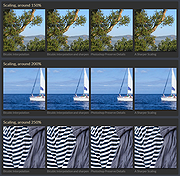 |
A Sharper Scaling v1.2
A Sharper Scaling v1.2
A Sharper Scaling is a free, high quality image scaling technology mainly developed for upscaling.
Examples
The following examples are most clear if the images are viewed in their original resolution. Otherwise, the browser does another image scaling on top, somewhat obfuscating the differences these examples are about.
It's usually easy to get the original resolution shown. On a Windows PC or Notebook, just hold down the Ctrl key and spin the mouse wheel up or down until the left side pattern of this test stripe looks exactly like a miniature version of the right side pattern (chessboard-like).
For comparison, all examples show the results of two conventional methods as well. Bicubic interpolation is what most image editors offer as the most appropriate method for image scaling. The interpolation results are a bit blurry, so another conventional action might be to sharpen them. (The sharpening method used for the examples is "unsharp masking".)
The 3rd alternative shown is a scaling method Adobe introduced in 2013 with Photoshop CC, called "Preserve Details". (I suppose it's also based on bicubic interpolation internally, but I may be wrong.) The function has a single adjustment "Reduce Noise" which was set to zero for the test because the pictures have very little noise only.
Digital Zoom
Small versions of whole pictures are probably not the most typical use case for image upscaling. Ideally, upscaling is the first geometric transformation, which means that the input still has the resolution of the camera. The next examples are details of pictures coming directly from the cam:
(These are critical details not random. Many other details don't show much difference between A.S.S. and a sharpened interpolation.)
Apart From Scaling
Although A Sharper Scaling does nothing but scaling images, it can also contribute to the quality of other geometric transformations like rotation, perspective correction, or lens ... |
 |
3,449 |
Jan 02, 2020
Steffen Gerlach  |












